Cédric Foy
UMRAE, Cerema Direction Est
Fully Reversing the Shoebox Image Source Method: From Impulse Responses to Room Parameters
May 06, 2024Abstract:We present an algorithm that fully reverses the shoebox image source method (ISM), a popular and widely used room impulse response (RIR) simulator for cuboid rooms introduced by Allen and Berkley in 1979. More precisely, given a discrete multichannel RIR generated by the shoebox ISM for a microphone array of known geometry, the algorithm reliably recovers the 18 input parameters. These are the 3D source position, the 3 dimensions of the room, the 6-degrees-of-freedom room translation and orientation, and an absorption coefficient for each of the 6 room boundaries. The approach builds on a recently proposed gridless image source localization technique combined with new procedures for room axes recovery and first-order-reflection identification. Extensive simulated experiments reveal that near-exact recovery of all parameters is achieved for a 32-element, 8.4-cm-wide spherical microphone array and a sampling rate of 16~kHz using fully randomized input parameters within rooms of size 2X2X2 to 10X10X5 meters. Estimation errors decay towards zero when increasing the array size and sampling rate. The method is also shown to strongly outperform a known baseline, and its ability to extrapolate RIRs at new positions is demonstrated. Crucially, the approach is strictly limited to low-passed discrete RIRs simulated using the vanilla shoebox ISM. Nonetheless, it represents to our knowledge the first algorithmic demonstration that this difficult inverse problem is in-principle fully solvable over a wide range of configurations.
Gridless 3D Recovery of Image Sources from Room Impulse Responses
Aug 30, 2022



Abstract:Given a sound field generated by a sparse distribution of impulse image sources, can the continuous 3D positions and amplitudes of these sources be recovered from discrete, bandlimited measurements of the field at a finite set of locations, e.g., a multichannel room impulse response? Borrowing from recent advances in super-resolution imaging, it is shown that this nonlinear, non-convex inverse problem can be efficiently relaxed into a convex linear inverse problem over the space of Radon measures in R3. The linear operator introduced here stems from the fundamental solution of the free-field inhomogenous wave equation combined with the receivers' responses. An adaptation of the Sliding Frank-Wolfe algorithm is proposed to numerically solve the problem off-the-grid, i.e., in continuous 3D space. Simulated experiments show that the approach achieves near-exact recovery of hundreds of image sources using an arbitrarily placed compact 32-channel spherical microphone array in random rectangular rooms. The impact of noise, sampling rate and array diameter on these results is also examined.
Mean absorption estimation from room impulse responses using virtually supervised learning
Sep 01, 2021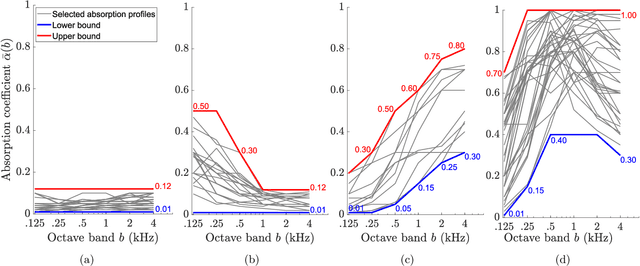
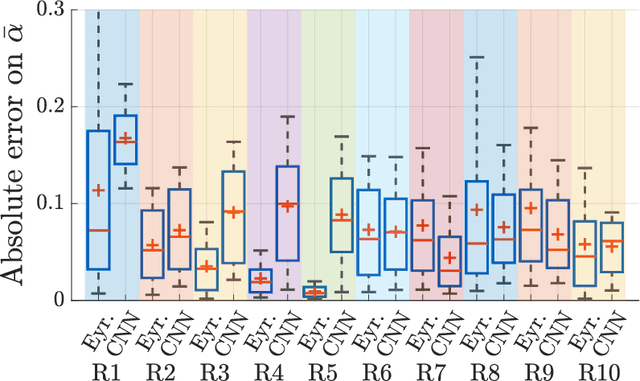
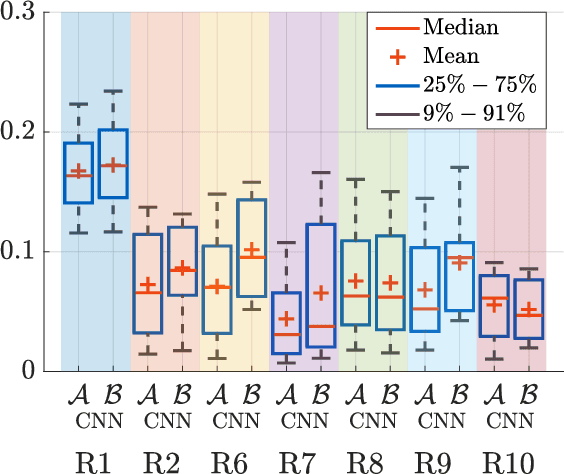
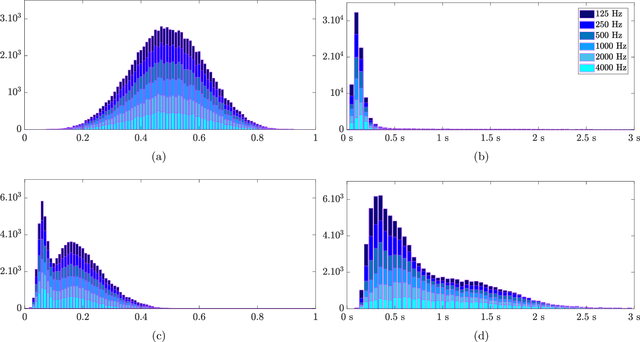
Abstract:In the context of building acoustics and the acoustic diagnosis of an existing room, this paper introduces and investigates a new approach to estimate mean absorption coefficients solely from a room impulse response (RIR). This inverse problem is tackled via virtually-supervised learning, namely, the RIR-to-absorption mapping is implicitly learned by regression on a simulated dataset using artificial neural networks. We focus on simple models based on well-understood architectures. The critical choices of geometric, acoustic and simulation parameters used to train the models are extensively discussed and studied, while keeping in mind conditions that are representative of the field of building acoustics. Estimation errors from the learned neural models are compared to those obtained with classical formulas that require knowledge of the room's geometry and reverberation times. Extensive comparisons made on a variety of simulated test sets highlight different conditions under which the learned models can overcome the well-known limitations of the diffuse sound field hypothesis underlying these formulas. Results obtained on real RIRs measured in an acoustically configurable room show that at 1~kHz and above, the proposed approach performs comparably to classical models when reverberation times can be reliably estimated, and continues to work even when they cannot.
dEchorate: a Calibrated Room Impulse Response Database for Echo-aware Signal Processing
Apr 27, 2021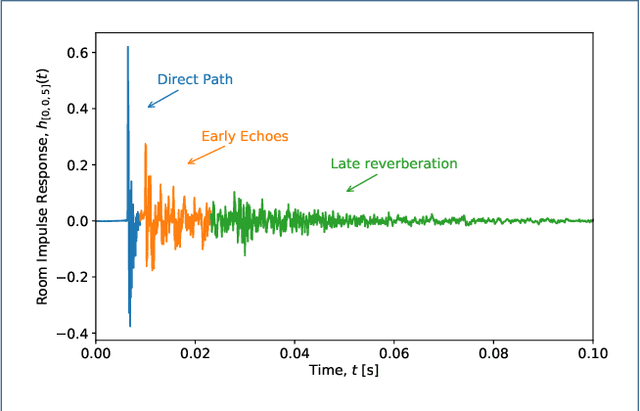
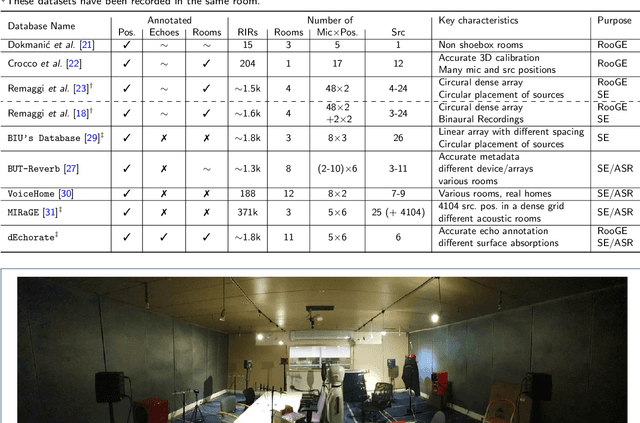
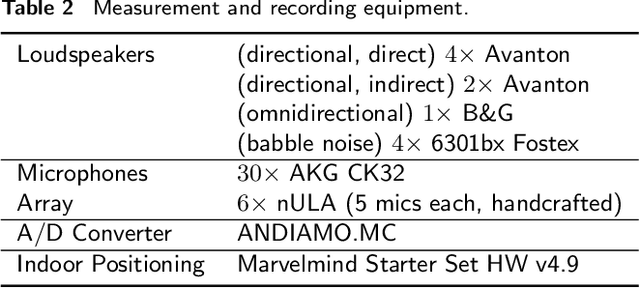
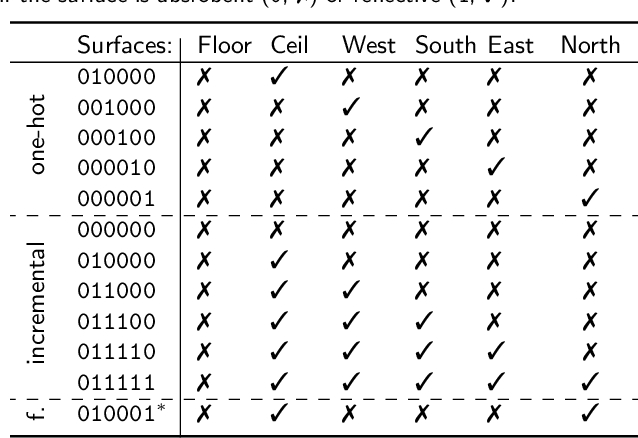
Abstract:This paper presents dEchorate: a new database of measured multichannel Room Impulse Responses (RIRs) including annotations of early echo timings and 3D positions of microphones, real sources and image sources under different wall configurations in a cuboid room. These data provide a tool for benchmarking recent methods in echo-aware speech enhancement, room geometry estimation, RIR estimation, acoustic echo retrieval, microphone calibration, echo labeling and reflectors estimation. The database is accompanied with software utilities to easily access, manipulate and visualize the data as well as baseline methods for echo-related tasks.
 Add to Chrome
Add to Chrome Add to Firefox
Add to Firefox Add to Edge
Add to Edge